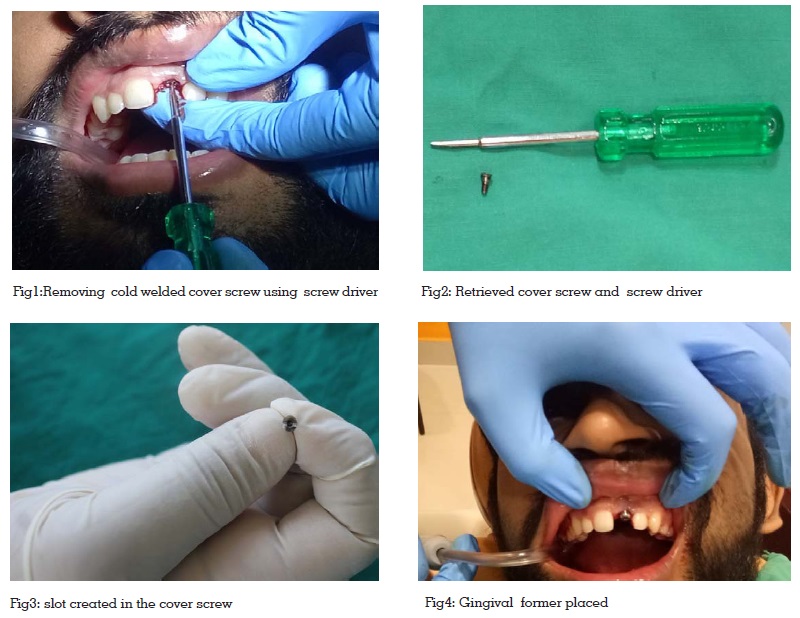

AIM: To illustrate a new technique to retrieve the cold welded cover screw
CASE REPORT: This case report describes how a cold welded cover screw was successfully removed with the help of a screw driver.
CONCLUSION: There is no universally accepted technique for the retrieval of cold welded cover screw. The technique described in this case report with the help of screw driver is a simple, cost effective method and can be used when conventional methods are not effective.
One of the most harrowing experience a dentist may encounter in his clinic is the inability to remove the cover screw from the implant after successful osseointegration. It is very difficult to remove the cold welded cover screw without damaging the internal threads of the implant.
The main reason for the this type of cold welding between the dental implant and the cover screw is the bone and blood debris that is present around the implant when the cover screw is placed. The fibrin component of the blood glues the cover screw and the implant together making it difficult for its removal.1,4,5 It can be also due to the manufacturing error of any of the two components, or due to the damaged thread of the hex driver.
In such situations dentists even will have to consider trephining out the dental implant which will be traumatic even for the dentist as well as the patient. Trephining can also cause further loss of the bone and we may have to think of enhancing the bone with the substitutes which will delay the further restoration.
Some of the methods that have described in the literature for the removal of the cold welded cover screw are,1,6
Besides understanding the reasons for cold welding precautions also should be taken to avoid such situations. After placing implants, thorough irrigation is recommended to avoid the wedging of blood bone debris between the contacting surfaces.
A 22 year old male patient reported to the dental clinic with the chief complaint of missing upper central incisor. Various available treatment options were explained to the patient and he finally decided to gofor the implant option for replacing the missing teeth. After radiographic examination and CBCT report, 4.2 X 11.5 mm (ADIN) implant was placed in his mouth.

After three months, an iopa was taken to evaluate the degree of osseointegration. As good osseointegration was achieved, a second stage surgery was planned and during the procedure ,it was found that due to cold welding, it was impossible to remove the cover screw. Applying cold ice and using an ultrasonic scaler was tried out unsuccessfully to remove the cover screw. Finally it was decided to create a slot on the surface of the cover screw with a tapered fissure diamond bur (width of 2mm and depth of 1mm) after which a screw driver of appropriate size (2mm width) was used . Screw driver was engaged in to the created slotandwas turned in an anticlockwise direction . Cold welded cover screw was successfully removed from the implant. During procedure care was taken not to damage the implant threads and a slot not exceeding a depth of 1mm was created on the surface of the cover screw.
Abutment was placed and fit of the abutment was verified clinically and radiographically. Healing abutments were placed, after thorough irrigation of the area.
Implant retained restorations can have both biological or mechanical failure.4,5 Cold welding of the cover screw is a rare mechanical complication encountered during second stage implant surgery. The main reasons could thebood and bone debris that gets wedged between the implant surface and the cover screw. It can also occur if screw has been over torqued during placement, or due to some manufacturing defect in the cover screw.
Different methods like application of ice, using ultrasonic scaleretc could not remove the coldwelded cover screw. So a slot was created and on the surface of the cover screw and an appropriate screw driver was used to remove it. This technique is simple, cost effective and can be incorporated in clinical situations where cold welded cover screws cannot be removed using conventional techniques.
Cold welding of cover screws is a rare complication. Adequate treatment planning, taking adequate precautionary measures , using correct torque for tightening the cover screw can reduce such complications.